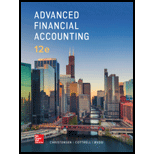
Concept explainers
a
Introduction: When an affiliate of the issuer later acquires bonds from an unrelated party, the bonds are retired at the time of purchase. The bonds are not held outside the consolidated entity once another company within the consolidated entity purchases them, it must be treated as repurchase by the debtor. The acquisition of an affiliate’s bonds by another company within affiliated entities is referred to as constructive retirement. Although bonds are not actually retired.
When constructive retirement occurs the consolidated income statement reports gain or loss based on the difference between carrying value and purchase price paid by the affiliate to acquire it. And it is not reported in the consolidated
The gain or loss on bond retirement reported in the 20X4 consolidated income statement.
b
Introduction: When an affiliate of the issuer later acquires bonds from an unrelated party, the bonds are retired at the time of purchase. The bonds are not held outside the consolidated entity once another company within the consolidated entity purchases them, it must be treated as repurchase by the debtor. The acquisition of an affiliate’s bonds by another company within affiliated entities is referred to as constructive retirement. Although bonds are not actually retired.
When constructive retirement occurs the consolidated income statement reports gain or loss based on the difference between carrying value and purchase price paid by the affiliate to acquire it. And it is not reported in the consolidated balance sheet either as bond payable or as an investment because the bonds are no longer outstanding.
The equity method entry P makes related to bond retirement
c
Introduction: When an affiliate of the issuer later acquires bonds from an unrelated party, the bonds are retired at the time of purchase. The bonds are not held outside the consolidated entity once another company within the consolidated entity purchases them, it must be treated as repurchase by the debtor. The acquisition of an affiliate’s bonds by another company within affiliated entities is referred to as constructive retirement. Although bonds are not actually retired.
When constructive retirement occurs the consolidated income statement reports gain or loss based on the difference between carrying value and purchase price paid by the affiliate to acquire it. And it is not reported in the consolidated balance sheet either as bond payable or as an investment because the bonds are no longer outstanding.
The elimination entry to remove the effect of intercompany bond ownership
d
Introduction: When an affiliate of the issuer later acquires bonds from an unrelated party, the bonds are retired at the time of purchase. The bonds are not held outside the consolidated entity once another company within the consolidated entity purchases them, it must be treated as repurchase by the debtor. The acquisition of an affiliate’s bonds by another company within affiliated entities is referred to as constructive retirement. Although bonds are not actually retired.
When constructive retirement occurs the consolidated income statement reports gain or loss based on the difference between carrying value and purchase price paid by the affiliate to acquire it. And it is not reported in the consolidated balance sheet either as bond payable or as an investment because the bonds are no longer outstanding.
The balance should be reported as consolidated
Want to see the full answer?
Check out a sample textbook solution
Chapter 8 Solutions
EBK ADVANCED FINANCIAL ACCOUNTING
- Can you show me the correct approach to solve this financial accounting problem using suitable standards?arrow_forwardI am searching for the accurate solution to this general accounting problem with the right approach.arrow_forwardPlease provide the solution to this general accounting question with accurate calculations.arrow_forward
- Please provide the solution to this general accounting question with accurate financial calculations.arrow_forwardKindly help me with this General accounting questions not use chart gpt please fast given solutionarrow_forwardI need the correct answer to this financial accounting problem using the standard accounting approach.arrow_forward
- Please explain the solution to this general accounting problem using the correct accounting principles.arrow_forwardI need guidance in solving this financial accounting problem using standard procedures.arrow_forwardWhat is the cost of goods manufactured for the year ended December 31, 2024 ?arrow_forward
 Financial AccountingAccountingISBN:9781305088436Author:Carl Warren, Jim Reeve, Jonathan DuchacPublisher:Cengage Learning
Financial AccountingAccountingISBN:9781305088436Author:Carl Warren, Jim Reeve, Jonathan DuchacPublisher:Cengage Learning Cornerstones of Financial AccountingAccountingISBN:9781337690881Author:Jay Rich, Jeff JonesPublisher:Cengage Learning
Cornerstones of Financial AccountingAccountingISBN:9781337690881Author:Jay Rich, Jeff JonesPublisher:Cengage Learning Intermediate Accounting: Reporting And AnalysisAccountingISBN:9781337788281Author:James M. Wahlen, Jefferson P. Jones, Donald PagachPublisher:Cengage Learning
Intermediate Accounting: Reporting And AnalysisAccountingISBN:9781337788281Author:James M. Wahlen, Jefferson P. Jones, Donald PagachPublisher:Cengage Learning




